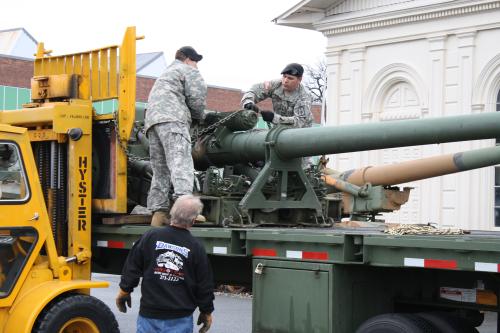History Returns to Watervliet with Help from the NYARNG
| DMNA Home page | More News Stories |
Story by: Staff Sgt. Thomas Wheeler - 138th Public Affairs Detachment
Dated: Wed, Apr 13, 2011
WATERVLIET, NY (April 13, 2011) -- A piece of artillery history returned to the Watervliet Arsenal today with a little help from New York National Guard Soldiers from the Queensbury, NY 1427th Transportation Company, as a high-tech howitzer developed at the Arsenal came home. The experimental lightweight 155mm howitzer had been sitting at the General Dynamics test range facility in Jericho, VT, since the conclusion of testing in the mid 1990’s. “It’s like capturing the prize,” said Bob Pfeil, curator for the Watervliet Arsenal Museum. “It will make a great addition to the museum,” he added. “It’s not just part of a system, it’s the whole system and that will give people a chance to see the whole piece and how it works.” Moving the one-of-a-kind gun was a good training experience for the 1427th Soldiers, said Staff Sgt. Richard Gorman, the unit training NCO. "The challenge presented for transporting this type of cargo created a great training experience," Gorman explained.
"The techniques we used to load, secure, and transport the equipment during this mission will have a positive impact on unit readiness and future missions we are tasked with," he added. According arsenal staff, General Dynamics donated the experimental howitzer to the Watervliet Arsenal museum at no cost in hopes that it will help tell the story of artillery warfare. “It’s history,” added Pfeil. “If it’s destroyed that history is lost forever.” This is the last remaining howitzer stemming from a1995 collaboration between defense contractors and the Watervliet Arsenal to design a replacement for the then standard 155mm howitzer. Arsenal staff added that the project was as result of lessons learned from battlefield experiences against Iraqi forces in the early 1990s. Combat systems had to be lighter and more mobile so that U.S. forces could decrease the time it took to deploy to future combat zones. Those responsible for the Army’s acquisition of field artillery systems took note of the need and turned to defense contractors, as well as to its sole Army-owned large caliber manufacturer, the Watervliet Arsenal, to design, test, and field a lighter artillery system. The result was a race by leading defense contractors, as well as the Watervliet Arsenal and co-inhabitant Benet Labs, to develop a lighter more mobile version of the standard of the day. “At first they [Lockheed Martin] came to us and said they wanted to just make the tube,” said design team member Stephen Van Dyke Restifo. Restifo went on to say that eventually they came to the team said they wanted them to build the whole system. "We were given full design authority for this design in August. Five months later the first gun was manufactured, designed and delivered out the door. It was followed by a second prototype a month later. What’s unique is that’s one of the quickest designs we’ve ever entered into," added Restifo. According to Watervliet Arsenal staff, the team designed, engineered, manufactured, and tested the howitzer all within one year’s time, a process that arsenal engineers say normally takes at least five years to accomplish. They went on to say that only two prototype howitzers were tested by then Lockheed Martin Defense Systems in the deserts of Yuma Proving Ground, AZ, in 1996 and although this gun was nearly 50 percent lighter than the 155mm towed howitzers that were in use by the U.S. military at that time, it was not selected by the Army for production and fielding. The gun was acquired by General Dynamics when the Lockheed Martin operation was sold in 1997 and finally returned home April 13, 2011.
URL: https://dmna.ny.gov/news/?id=1302790570
216.73.216.182
Page Last Modified: Thu, Apr 14, 2011




